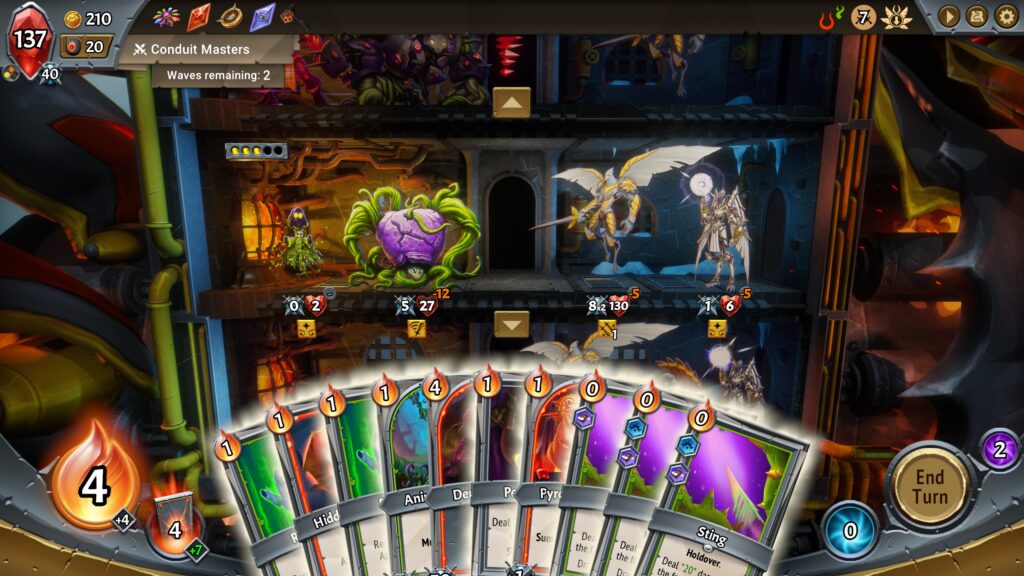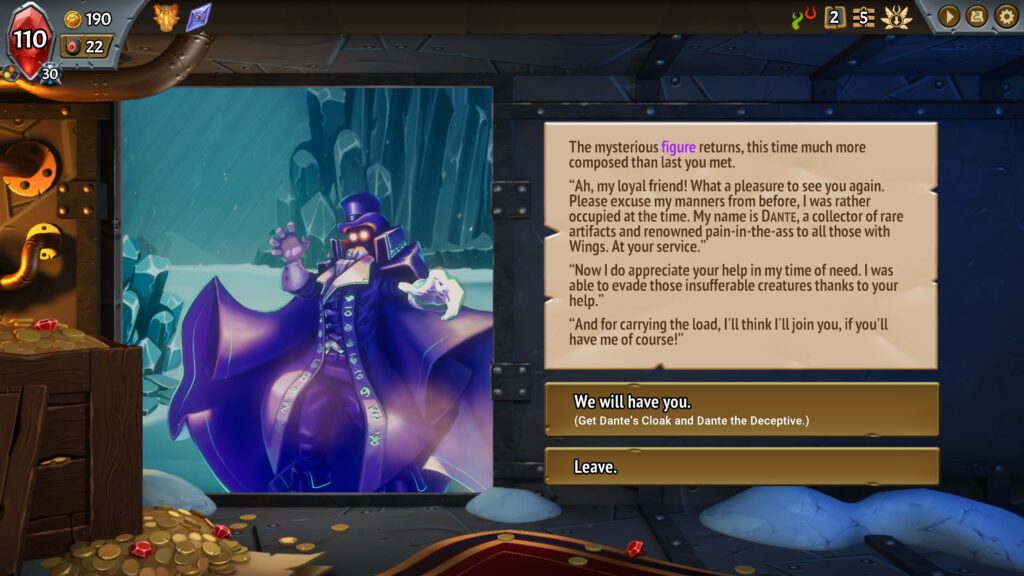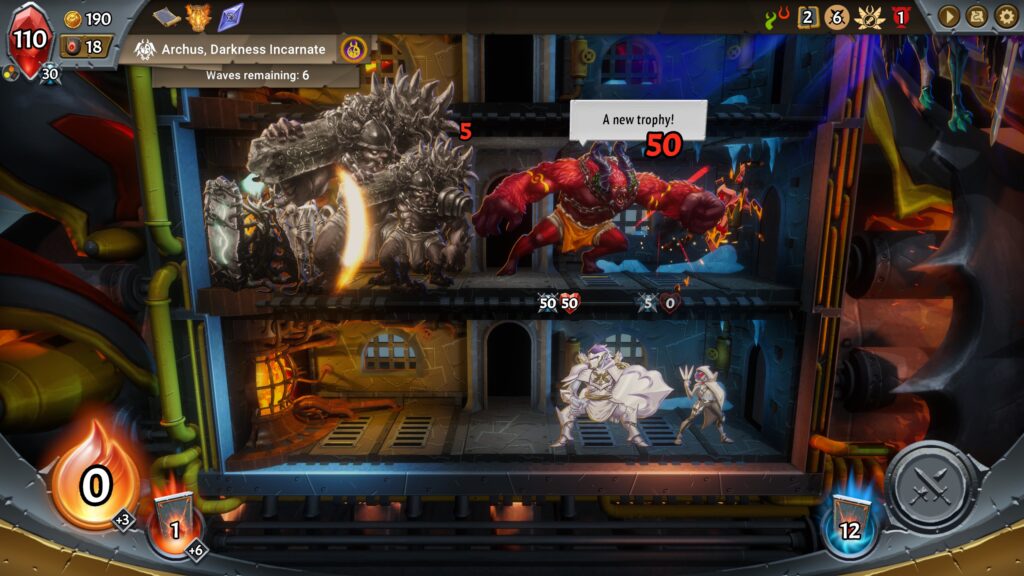
I loved Slay the Spire, so it was only a matter of time before I got around to playing this deckbuilder game that was clearly inspired by it. It flips the theme around so you’re playing as the forces of hell fighting against good but the story hardly matters in a game like this. It modifies the formula so that you’re deploying monsters to defend a number of distinct battlefields for example. On the whole, it’s very similar however so those who loved Slay the Spire should love this as well. I’d say that the design here isn’t quite as elegant as its inspiration and it’s also a more forgiving game. Yet combined with its better production values, I found myself playing this a lot more than I’d expected.
Instead of playing a hero of some sort, you control a train that is carrying a pyre that must reach the heart of hell to reignite it. You lose the game when the pyre is extinguished, that is loses all hit points, and win when you beat the final boss. The metaphor gets a little strained since the train carriages are presented more like floors with enemies entering at the bottom floor and needing to reach the topmost floor where the pyre is. One thing you have to watch out for is that your monsters and the invading enemies don’t fight to the death on each floor. Instead they’ll fight one round of combat and the surviving enemies will advance to the next floor. Only the boss will fight to the death. In between fights, you can heal your pyre, get more cards to add to your deck and even buy upgrades for your existing cards. There’s really not much to the story, not even in the way of flavor text. The names of the cards and the excellent art do help plus there are the random events in between battles that offer a glimpse into this world.

Instead of the cards being divided according to character class, here they are divided by clan. You pick a primary clan and an allied clan and cards from sets will be available throughout this particular run. In addition, you also start with a champion card from the primary clan. These are distinct from the regular monster cards as they have unique powers and upgrade paths. But it’s still up to you whether to build a deck around your champion or use it as extra help. The champion dying during a fight doesn’t matter at all as it’s still just a card. With five clans in the base game and two champions in each clan after you unlock everything, there’s a lot of replayability in trying out all of the possible combinations. Once you play a monster card and it dies, it’s gone for the rest of the fight unless there is a mechanic to revive it. But you cycle through the spells in your deck again and again. Each clan uses the same basic resource mechanics, embers, and there is a capacity limit to how many monsters can fit on each floor. But each clan does have unique quirks such as the Umbra being able to generate morsels that are eaten by other monsters to give them bonuses. This can be thought of as a kind of special resource.
One major difference between this game and Slay the Spire is that a run here consists of many fewer fights. In between each fight, you get multiple opportunities to heal, upgrade, get more cards and so on. Even the random events are guaranteed to be beneficial since you can always decline to participate. The result is that you have very many opportunities to reshape your deck as you wish. It’s easy to eventually drop every unwanted card and even max out the upgrade slots of the cards you do choose to keep. You can drop the casting cost of your spells to zero, beef up your monsters, even duplicate maxed out cards. This means that while Slay the Spire has you take risks with random events and make do with cards you don’t really want, playing Monster Train is a much more relaxing experience. You may not always get the artefacts and cards that you want but you’re never saddled with useless cards either. Even when you’re offered cards you don’t want, you can always skip them and take money instead to spend in the shops.

Fun and enjoyable as this is, I still think Slay the Spire is the more elegantly designed game. There’s a deep cleverness in its cards, placement and design of enemies, even the handicaps from higher ascensions that just aren’t present here. Monster Train instead has crazy big numbers once you learn how to scale up and insanely powerful cards especially as you get to upgrade them in a variety of ways. It is harder or even nearly impossible to achieve infinite chains in this game since almost all card draw effects delay the bonus draw until the next turn. Yet it’s also perfectly happy to hand you absurdly overpowered cards like the Transcendimp that can quickly push your buffs up to huge numbers. The handicap for higher difficulty levels, called Covenants here, aren’t too onerous either, making the climb feel like a normal part of the game rather than an advanced New Game Plus mode for experts only.
Between the many clan and champion options plus the unlockable cards, there is a lot of gameplay to be had here. The fact that there are three levels plus the pyre room itself adds a new tactical consideration as you must decide if you’re going to build one unstoppable floor or spread your units out across floors. There’s not much pressure in this game and the very many options it gives you to improve your deck made me come back again and again for more runs. However I also realized that in order to beat the game, you really only need one good combo. You need to have tools to deal with enemies who can hit your backline of course and you need to be prepared to face the particular flavor of end boss of each run. But the game tells you in advance what to prepare for so you have plenty of time to build your deck accordingly. The enemies have some nasty tricks for the unaware but they’re nothing like the strict checks in Slay the Spire. I had a lot of fun with this and I think it’s a worthy successor but it never struck me as being brilliant in the way the earlier did. Still, it’s solid and it looks good and that counts for a lot.
